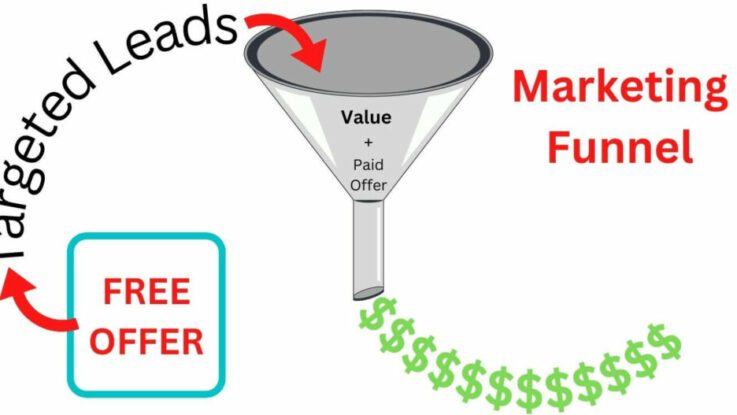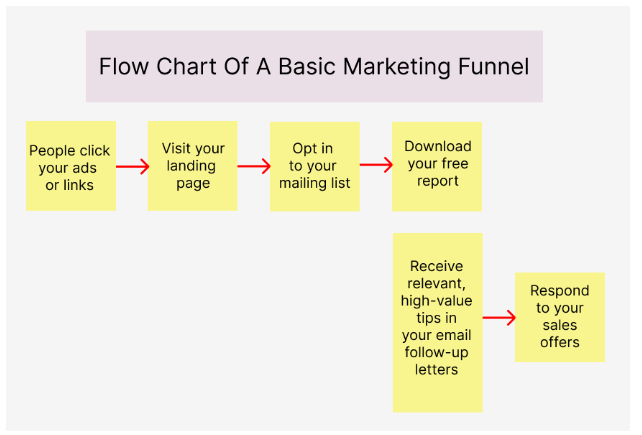
This is the first in a series of modules that will show you how to build a marketing funnel from the landing page to the high-ticket offer on the back-end.
But before we look at how to build one, let’s look at what a marketing funnel is.
Module 1: What Is A Marketing Funnel?
An effective marketing funnel for online affiliate marketers includes a landing page, email follow up, and a series of product/service “offers” – the things that you are selling.
By creating a well-crafted funnel, you can ensure that people take the desired action and make a purchase. By offering value throughout the funnel, you can build trust and keep people engaged.
Finally, as your subscribers learn to “know, like and trust” you, you can present them with higher ticket offers as they progress through your marketing funnel. That way, you can make sure that people are making a worthwhile investment.
1. Definition of a Marketing Funnel
A marketing funnel is a process designed to turn potential customers into first time buyers and then repeat customers. People visit a “landing page” and fill out a form to join your mailing list. They receive emails that provide valuable information and product offers in the hope of converting those subscribers into customers.
Here’s what a basic marketing funnel looks like:

2. The Landing Page (or “Lead Capture Page)
The lead capture page is a basic web page that invites visitors to “opt in” to a mailing list by entering their email address (and maybe their name, and sometimes even their telephone number). It should include some info about what is on offer, a “call to action” (such as “Enter Your Email Address For More Info”). Some lead capture pages offer a “freebie” such as a free ebook or video, but it is not necessary if your offer is compelling enough.
Here are three of my own lead capture pages, only one of which offers a free ebook:
- Example 1: Crypto accumulation for beginners (no free ebook)
- Example 2: Internet marketing training (with free ebook)
- Example 3: Leadsleap video training course (no free ebook)
3. The Email Opt-In Form
This is the form that potential customers fill in on the landing page to join your mailing list. The sole purpose of a landing page is to get visitors to fill in the email opt-in form.
4. Autoresponder for Email Follow-up
Once someone has submitted the opt-in form (and confirmed their subscription) the autoresponder will automatically send them email letters at predetermined intervals.
How often should you send emails to your subscribers? Some people prefer to send an email letter once or twice a week. Others, such as myself, prefer to send out emails once a day. Then again, there are others who send emails multiple times a day. You can test what works best for your target market by keeping an eye on the response rates and the number of people who unsubscribe from your list.
5. Relevance and Value
No matter how often you send out emails, your emails should offer free, high value content that is relevant to the market you serve. Here are just a few examples of what you could write about:
- The Hero’s Journey: Keep your subscribers updated about your progress as an Internet marketer. Include stories about your failures and the lessons they taught you, as well as your successes and success tips.
- Case Studies of Successful Affiliate Campaigns: Provide detailed case studies of successful affiliate marketers who have achieved significant results. Break down their strategies, tactics, and key takeaways, so your audience can learn from real-world examples.
- Step-by-Step Affiliate Marketing Guides: Create comprehensive guides that walk affiliate marketers through the process of setting up successful campaigns. Cover topics such as niche selection, product research, content creation, traffic generation, and conversion optimization.
- Exclusive Interviews with Industry Experts: Conduct interviews with successful and well-known Interenet marketers and industry experts. Post the interview as a YouTube video, then send an email to your list subscribers with a link to the video.
- Product and Tool Recommendations: Offer a curated list of top-performing affiliate products and marketing tools. Include reviews, benefits, and special deals for your subscribers.
- Email Marketing Templates: Share a collection of highly converting email templates that your subscribers can copy and adapt for their own email campaigns.
Remember, the key is to focus on providing content that directly addresses the needs, challenges, and aspirations of your target audience. By offering valuable, relevant, and actionable information, you can establish yourself as a trusted authority in the field and build a loyal subscriber base. Loyal subscribers are much easier to convert into regular customers.
6. Offers (Your Products and Services, or Affiliate Products and Serivces)
Start with a low-ticket high-value offer. Delay offering your high-ticket product or service until later in the marketing funnel when the subscriber has learnt to “know, like and trust” you thanks to the quality and relevance of your email newsletter.
This is perhaps the toughest lesson for inexperienced Internet marketers to learn. People are so keen to sell their big offer as quickly as possible that they often jump over the vital relationship-building steps that ensure more sales in the long run.
7. Recommended Marketing Funnel Builder
I believe Leadsleap.com is the best platform for affiliate marketers to set up marketing funnels. You can set up a basic marketing system (landing page and email list) for free and upgrade later when you are ready to build a completely automated email follow-up letter series.
Or, you can clone my Get More Sales marketing funnel which is built on the Leadsleap platform, and start generating multiple streams of online income without the hassle of designing and building your own funnel.
Any questions? Post them in the comments, below.
This training module was originally part of a members’ only “Conversion Catalyst” training series. I am now making the whole “Conversion Catalyst” training series freely available on DavidHurley.net.
David Hurley
#InspiredFocus
#ConversionCatalyst
Module 2: Setting Up A Basic Marketing Funnel
